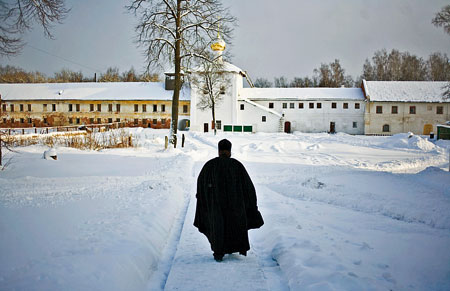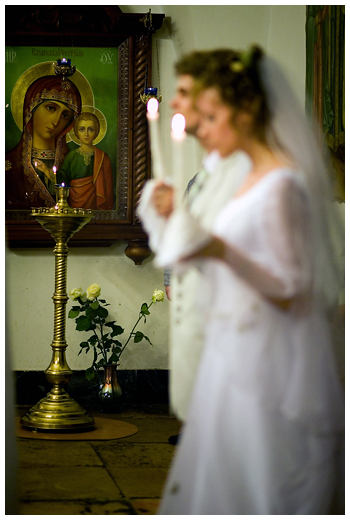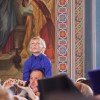Source: The Web site of the Parish of the Protection of the Holy Virgin Mary
The traditional teaching of the Orthodox Church that monasticism is a “higher” or the ‘highest’ spiritual calling is received by many converts as an oppression and a confusion. If monasticism is a higher calling, so they tend to reason, and I am called to married life in the world, it seems I am required to live according to a ‘lower’ calling, which is a rather dispiriting and discouraging prospect. Furthermore, the ascetical literature of the Orthodox Church is so heavily weighted toward living the monastic life that ‘lay’ people, especially converts, find it hard to see where they fit in and how all this ‘monastic’ teaching applies to them. Many married and single converts feel that a definite ceiling is placed on their spirituality: as ‘lay’ people living according to a ‘lower’ calling in the world, less is required of them spiritually, and, what is far worse, less is expected. Assuredly, they are told, lay people can be ‘saved’ while living a life of attachments in the world by following as best they can the precepts and practices of the Church. Unfortunately, the married or non-monastic single convert is made to feel by this approach (which basically errs by teaching a half-truth, as I will discuss below) that he or she is condemned to ‘second-class citizenship’ in the Kingdom.
Some observers, noting the increased numbers of formerly Evangelical Protestant Christians entering the Orthodox Church, believe that the emergence of this problem about monasticism among converts is based on the antipathy toward and lack of familiarity with monasticism in the Protestant world. But this is to ignore the fact that this confusion also exists even among the equally large number of Anglican/Episcopalian and Roman Catholic converts, who come from traditions that encourage and honor monasticism. Clearly this perceived opposition between marriage and monasticism is not merely the result of the former religious affiliation of converts to Orthodoxy.
There are a number of contributing factors at work helping to create the climate for this confusion about the role of monasticism in the life of married and non-monastic single people in the Church. It is crucial that Church leaders, theologians, catechists and evangelists take account of these as the Orthodox Church expands its missionary and evangelistic efforts in the West.

1) First is the split between Church and culture in the West, a factor seriously underestimated by many Church leaders from the Old Country. Traditional Orthodox societies were, whatever their historical faults, basically normal and human. In traditional Christian societies, whether Semitic, Slavic, Greek or Celtic, Church and culture supported one another: priest, politician and parent all worked for the same things. Marriage and monasticism were organically united in a community whose lifeblood was the Divine Liturgy, whose lifestyle was traditional asceticism, whose ‘biorythmns’ were ordered by the cycle of Church services and whose national holidays and celebrations were the great annual Feasts of the Orthodox Church. But in contemporary Western society, American or European, this organic link between Church and culture has been severed at the root.
2) Secondly, account needs to be taken of the low level of spiritual culture in contra-distinction with intellectual and technical culture in the ‘post-modern’ world, both in the West and in the East. A contemporary elder from Sihastria Monastery in Romania (which is perhaps the equivalent of Optina Monastery in 19th century Russia) was asked why zeal for prayer and good works were so weak today. He responded, “Because faith has diminished in the whole world. Today every layman and monk confesses that he cannot pray as they did in the past. Only with great labor and pains can some good monks and laymen maintain pure prayer day and night. We others are always surrounded by cares, people and weaknesses, and when we pray our minds are scattered and full of thoughts” (Spiritual Conversations with Romanian Elders, by Fr. Ioanichie Balan). This is a contemporary confirmation of the ancient prophecy of Abba John the Dwarf: “Here is what one of the old men in ecstasy said: ‘Three monks were standing at the edge of the sea, and a voice came to them from the other side saying, ‘Take wings of fire and come here to me.’ The first two did so and reached the other shore, but the third remained, crying and weeping exceedingly. But later wings were given to him also, not of fire, but weak and without strength, so that with great difficulty he reached the other shore, sometimes under water, sometimes above it. So it is with the present generation; if they are given wings they are not of fire, but wings that are weak and without power”(The Desert Christian, Benedicta Ward). Many Orthodox leadersare certainly well aware of this situation, which possibly contributes to their reluctance to promote with much vigor or enthusiasm traditional Orthodox ascetic and monastic spirituality in their adopted lands.
3) Thirdly, there is the confusing, somewhat insensitive and basically ineffective way the “monastic ideal” is often presented to Western converts. I am reminded of a warning given by Fr. Seraphim Rose in one of his writings where he speaks of the “weight” of the entire tradition of Orthodoxy in all its magnificence and transcendence relentlessly bearing down on the hapless convert, sometimes pushing him right out of the Church. Orthodox monastic asceticism with its lofty ideals and uncompromising rigor is indeed a weighty concept, especially to us children of the present age, accustomed as we are to understanding life in terms of all the many forms of comfort provided without effort by our culture in its incessant pursuit of ‘happiness’. I will devote the remainder of this article to addressing primarily these latter two factors.
There is an axiom in the Orthodox Church, borne out by history, that says “as goes monasticism, so goes the Church”. The health of monasticism is a barameter of the health of the Church. It is an inexcapable fact, however, that, by the standards of the past and even of the ‘Old Country’ in the present, Orthodox monasticism is weak in the West. In traditional Orthodox societies of the past, where monasticism and marriage were organically united in the culture, there is good evidence that the asceticism practiced by ordinary families and simple peasants surpassed in rigor and intensity what is practiced in most monasteries in the West today. All of the factors mentioned above have probably contributed to this state of affairs, not to mention the enormous dislocation and cultural shocks of the so-called Orthodox ‘diaspora’.
Be that as it may, what is certain is that today a bridge is desperately needed between the monastic, ascetic ideals in Orthodoxy and the intellectual and psychological formation of contemporary Orthodox people. The attempt to “cure” the present situation by seeking to disseminate the ‘monastic ideal’ as a kind of panacea fails to provide the needed bridge because monastic asceticism is too often presented in a dogmatic, disembodied and undiscerning manner. Two unfortunate results then occur: 1) an enormous weight is placed on the soul of the Orthodox Christian, especially if he or she is fervent and idealistic, as so many converts are, which may have harmful effects; and 2) a tremendous opportunity for teaching the genuine ascetic way in terms the modern soul can understand and utilize is lost.
The solution to the confusion of ‘higher’ and ‘lower’ callings is not to insist doggedly and hence ‘dogmatically’, even if correctly, that the entire tradition declares monasticism to be the higher calling. On the other hand, neither is it particularly beneficial to rummage through the writings of St. John Chrysostom and other patristic writers to find ‘proof texts’ in support of the loftiness of the ‘marriage ideal’. Neither of these approaches will solve the problem. To discuss the monastic ideal in this way is ineffective because disembodied, due to the fact that real monasticism is abstracted from the life of the Church in the West, both as a conceptual ideal and as a concrete reality. Therefore, in regard to marriage and monasticism, we need to ask ourselves the same question that Paul put to the Corinthians about the body and its members (1 Cor. 12: 12-31). In the unity of the human physical body, it is meaningless to talk of different but essential organs having more or less honor. Can the eye (monasticism) say to the hand (marriage), I have no need of thee? Paul used the metaphor of the body and its inherent symbolism to deal with precisely the same question of ‘higher’ and ‘lower’ spiritual gifts to show us that in the reality of the Body of Christ, there is an organic, eucharistic unity of all gifts and callings.
We need to understand what the witness of tradition is really telling us so that this wisdom might be ‘unpacked’ in a way that will be of benefit to the present generation. Following a technique of St. Maximos the Confessor, we must ‘distinguish in order to unite’. Let us seek first to distinguish those elements in this question which may have gotten conflated or confused so that we might then see their inherent harmony and unity. There seem to be three such areas: 1) the conflation of monasticism and asceticism; 2) the confusion of the ‘monastic ideal’ with the institution of monasticism; 3) the dual meaning of the word monasticism: ‘outer’ monasticism and ‘inner’ monasticism. In doing this, St. Paul’s rhetorical question about the relative merits of the body’s members answers itself.

1) We need to distinguish asceticism from monasticism. Many converts, awash in the wonderful spiritual literature of the Orthodox tradition, like thePhilokalia, the Ladder of Divine Ascent or Unseen Warfare, receive the impression that only monastics are called to be ascetics. Nothing could be further from the truth. All Christians are called to the ascetic life. In Matthew 16, Jesus gives us the fundamental law of Christian discipleship: “If any man will come after me, let him deny himself, and take up his cross, and follow me. For whosoever will save his life shall lose it: and whosoever will lose his life for my sake shall find it”(Mt.16:24-25). The essence of the ascetic life is precisely denying oneself for Christ’s sake and taking up one’s cross to follow Him. There is no other way to follow Christ; it is ascetic through and through and all Christians, monastic, clergy and laity have the same path.
To show the universal nature of Orthodox ascesis and its intimate union with noetic prayer, let us look at the ringing declaration of St. Simeon of Thessalonica about praying with the Name of Jesus Christ (Little Russian Philokalia, Vol.4, p.146):
Let every pious man continually repeat this Name as a Prayer in his mind and with his tongue. Let him always constrain himself to do this while standing, traveling, sitting, resting, speaking, and doing all things. Then he shall find great peace and joy, as those who have occupied themselves with it know from experience. This activity is both for those in worldly life and for those monks who are in the midst of turmoil. Each one must strive to occupy himself with this Prayer, even if to a limited extent only. All, clergy, monks and laymen, must have this Prayer as a guide, practicing it according to their ability.
The monks are dedicated, and have an indispensable obligation to do this…The clergy must be diligent in this Prayer as though it were apostolic work and Divine preaching …Let those who are in the world work at this as a sealing of themselves, a sign of their faith, a protector, sanctification, and expeller of every temptation…let everyone devote time, according to his ability, and have a certain amount of this Prayer as an obligation.(Italics added).
Following this, it does not seem necessary to cite the multitude of possible patristic sources which would confirm our point in order to conclude that the Christian way of ascesis, the way of the cross, is not automatically monasticism, which is but one of its forms, though the preeminent one. Ascesis is required of all Orthodox Christians.
2) We need also to distinguish between the institution of monasticism and the ‘monastic ideal’. According to St. Theophan the Recluse, the institution of monasticism consists of the monastic ranks (novice, ryassaphore, full tonsure, great Schema), the monastic rule (the major points of which are fasting, obedience, prayer) and the monastic forms (cenobitic, eremetic, sketic). This is the ‘external image’ of monasticism. But the ‘internal image’ of monasticism, its essence, according to St. Theophan, is “a perpetual labor of conquering passions and uprooting them in order that one may preserve oneself before the face of God in a pure and immaculate state”. Clearly single and married non-monastics do not live according to monasticism’s external order, but who would dare to say that non-monastic Christians do not also have the responsibility to labor perpetually to conquer passions in order to preserve themselves before God in a pure and immaculate state? As Theophan himself says, “There are lay women in light-colored dresses who are nuns in spirit and there are monastics in black mantles who are laywomen at heart” (Kindling the Divine Spark). From this perspective, lay people, according to St. Theophan the Recluse, need not feel themselves excluded from any spiritual possibility simply on the basis of their life amid the cares of the world.
3) Finally, we need to distinguish between monastic spirituality in its two meanings: outer monasticism and inner monasticism. According to St. Maximos the Confessor, “A monk is a man who has freed his intellect from attachment to material things and by means of self-control, love, psalmody and prayer cleaves to God”(Char.2:54). Again, the Confessor points out even more forcefully: “He who has renounced such things as marriage, possessions and other worldly pursuits is outwardly a monk, but may not yet be a monk inwardly. Only he who has renounced the impassioned conceptual images of these things has made a monk of the inner self, the nous. It is easy to be a monk in one’s outer self if one wants to be; but no small struggle is required to be a monk in one’s inner self” (Char.4:50). This seems identical to St. Theophan the Recluse’s teaching on the ‘internal image’ of monasticism, in which the possibility of participating, as we have seen, is not excluded from lay people. That the phrase “no small struggle” is a massive understatement by St. Maximos is revealed in his next statement: “Who in this generation is completely freed from impassioned conceptual images, and has been granted uninterrupted, pure and spiritual prayer? Yet this is the mark of the inner monk” (Char.4:51). The point of these quotes, and indeed of this essay, is not to deny the preeminence of monasticism as the paradigm of spirituality in the Orthodox tradition. It is, however, to call for a little more sobriety when invoking the ‘monastic ideal’ by showing that from the perspective of the heights of the hesychastic tradition, the monastics and lay people of today are more or less in the same boat, or, according to the vision of Elder John the Dwarf, equally at sea on shaky wings.
Besides the distinctions between asceticism and monasticism and outer and inner monasticism, we need to introduce one further concept in order better to clarify our approach toward the principles of non-monastic asceticism: spirituality. We are working with three basic concepts which are often confused or substituted for one another: monasticism, asceticism, spirituality. Spirituality, a term notoriously difficult to define, has a broader, more inclusive sense than the other two terms, and, in the Orthodox meaning, includes a patristic mentality, the experience of life in Christ and reflection on that experience. In that sense, we can say, with Metro. John Zizioulas (Being and Communion), that from the time of the early Church, there have been two basic types of spirituality in Holy Orthodoxy: one may be called “eucharistic”, because it is based on the eucharistic community, its experiences and disciplines. The other type is called ‘monastic’ by Zizioulas, but I prefer to call it ‘hesychastic’, both because it more precisely describes the type of spirituality that we are distinguishing from the ‘eucharistic’, and also because I do not want to imply that the eucharistic dimension can ever be separated from monasticism–or from hesychasm, for that matter. (We are distinguishing here, let us recall, not to separate but only to unite.) In both the eucharistic type of spirituality and the hesychastic, the practice of asceticism is fundamental: the individual struggles against the passions, strives toward the virtues, seeks grace in prayer and union with God in Christ. Hesychastic spirituality is characterized not only by renunciation of the world and austere asceticism but especially by submission to the spiritual authority of a geron or staretz, which includes such practices as strict obedience and daily revelation of thoughts, activities not practicable for the average lay person. Eucharistic spirituality, on the other hand, is characterized by an ascetical and noetic participation in the eucharistic community as a way to overcome philautia: self-love and its deadly children, gluttony, avarice, vain-glory, etc. Ultimately, however, both types of spirituality are but modes of the one spirituality of the Orthodox Church, which is the path of becoming a temple of the Holy Spirit by participating in the uncreated grace and the deifying energy of God. Orthodox spirituality, then, both eucharistic and hesychastic, is the spirituality most perfectly embodied in the saint.
Normally, the type of spirituality most natural to married and non-monastic single people is the eucharistic. In this form of spirituality, Jesus Himself is our ‘spiritual father’ through the Eucharist and the priesthood, and the Church is our spiritual mother. Our families are our ‘cells’. Just as the monk is told by his elder, ‘stay (or sit) in your cell and your cell will teach you everything’, so too for us non-monastics, our spiritual mother the Church teaches: stay in your families (which are the Church in microcosm) and your families will teach you everything. The three primary acts of the Church–prayer, fasting, almsgiving–provide with the sacramental and liturgical cycle of life a complete ascetic rule that is inexhaustible and perfectly adaptable to our strengths (or weaknesses). There is nothing spiritually limiting or restricting in the eucharistic spirituality of the Church, no grace absent, no spiritual door closed.
Above all, there is no ceiling on sanctity or holiness in the biblical, eucharistic spirituality of Holy Orthodoxy: Jesus’ command in Mattthew 5 is addressed to all Christians: “Be ye therefore perfect, even as your Father which is in heaven is perfect” (Mt.5:48). Monasticism, after all, is not an end in itself. The ‘monastic ideal’ is not monasticism itself but something higher than itself: martyrdom. Let us remind ourselves that monasticism began as a form of martyrdom, ‘white’ martyrdom; and martyrdom is nothing more or less than the total denial of oneself for the sake of Christ and the cross, a path of grace not limited to monks but open to all Christians.
The instruction of the great elder and saint, Paisius Velichkovsky, for the tonsure to the Monastic Order, is equally applicable, with slight adaptation, to Orthodox married and non-monastic single persons. We have, says St. Paisius, three enemies against which we must fight daily warfare: the first and fiercest is the devil, the second is our bodies, the flesh; the third is the world. The first degree of ascetic combat is with the world. Unlike the monk, we cannot abandon marriage, family, possessions. We do not renounce them. But we can and must renounce sinful attachment to them; we can, following St. Maximos, strive to renounce the passions that hold us attached to things and not to God. The second arena of unseen warfare is the flesh. We non-monastics are obliged as much as monastics to restrain ourselves from much pleasurable food and intemperate drinking. By fasting we seek to slay the desire for sin and various sin-arousing provocations; by wakefulness in times of prayer we seek to destroy slothfulness; and other passions too, we seek to overcome by the remembrance of God, which only comes with suffering endured in a spirit of devotion (St. Mark the Monk). Yet our body is also our friend, for with its help, we can fast, make prostrations, give alms, pour out tears. This is why St. Gregory Palamas spoke of our relationship with the body as “being harnessed together and being estranged, of a merciful enemy and a treacherous friend” (Oration 14). Our third enemy is the devil himself, against whom we are engaged in a most difficult struggle, visible nature against invisible. Here our weaponry is ‘the full armor of God’, truth, righteousness, the Gospel of peace, faith, patience and prayer(Eph.6:11-18), which we claim by striving to keep the commandments of Christ and of the Church, seeking to acquire the true wealth of the virtues. Thus the key to non-monastic asceticism is: strive without ceasing, according to one’s ability, trusting in God and his Bride, the Church, not in oneself.
Amen.
Published in Again Magazine, 1996















